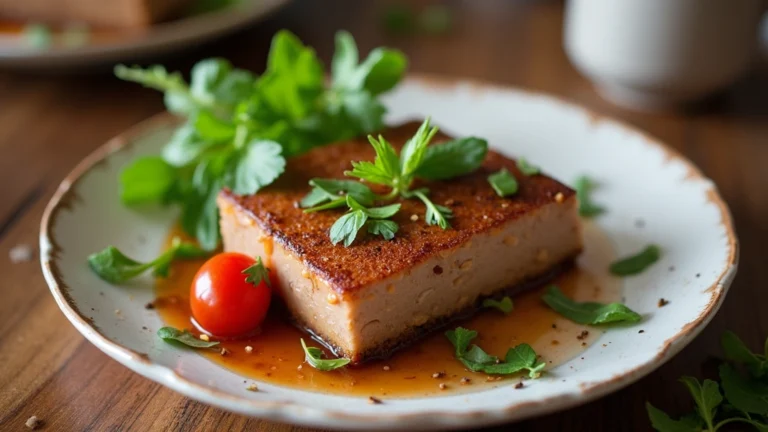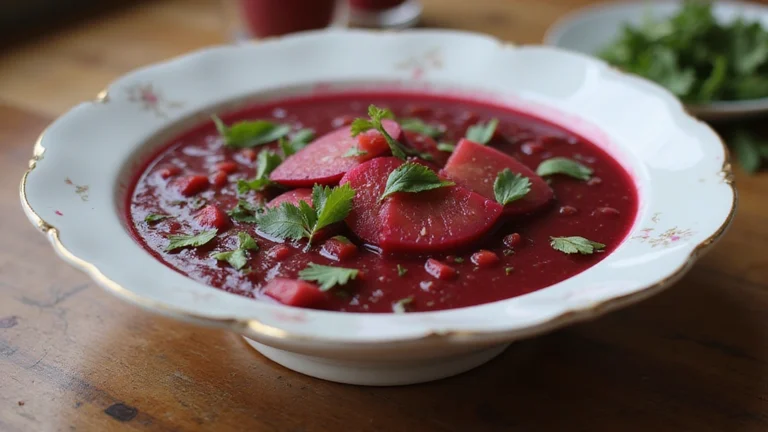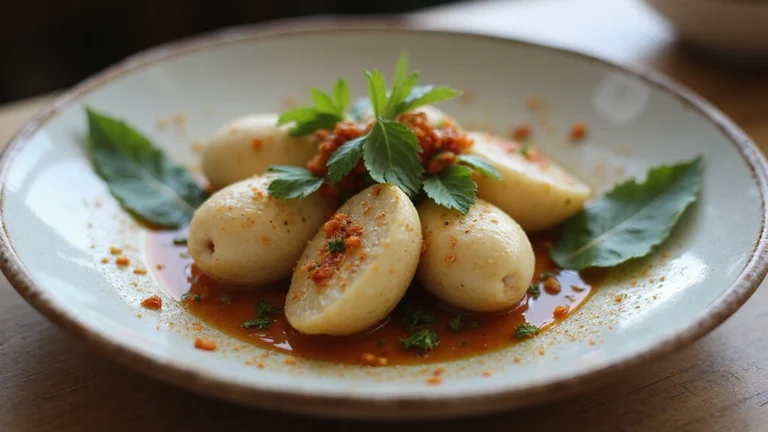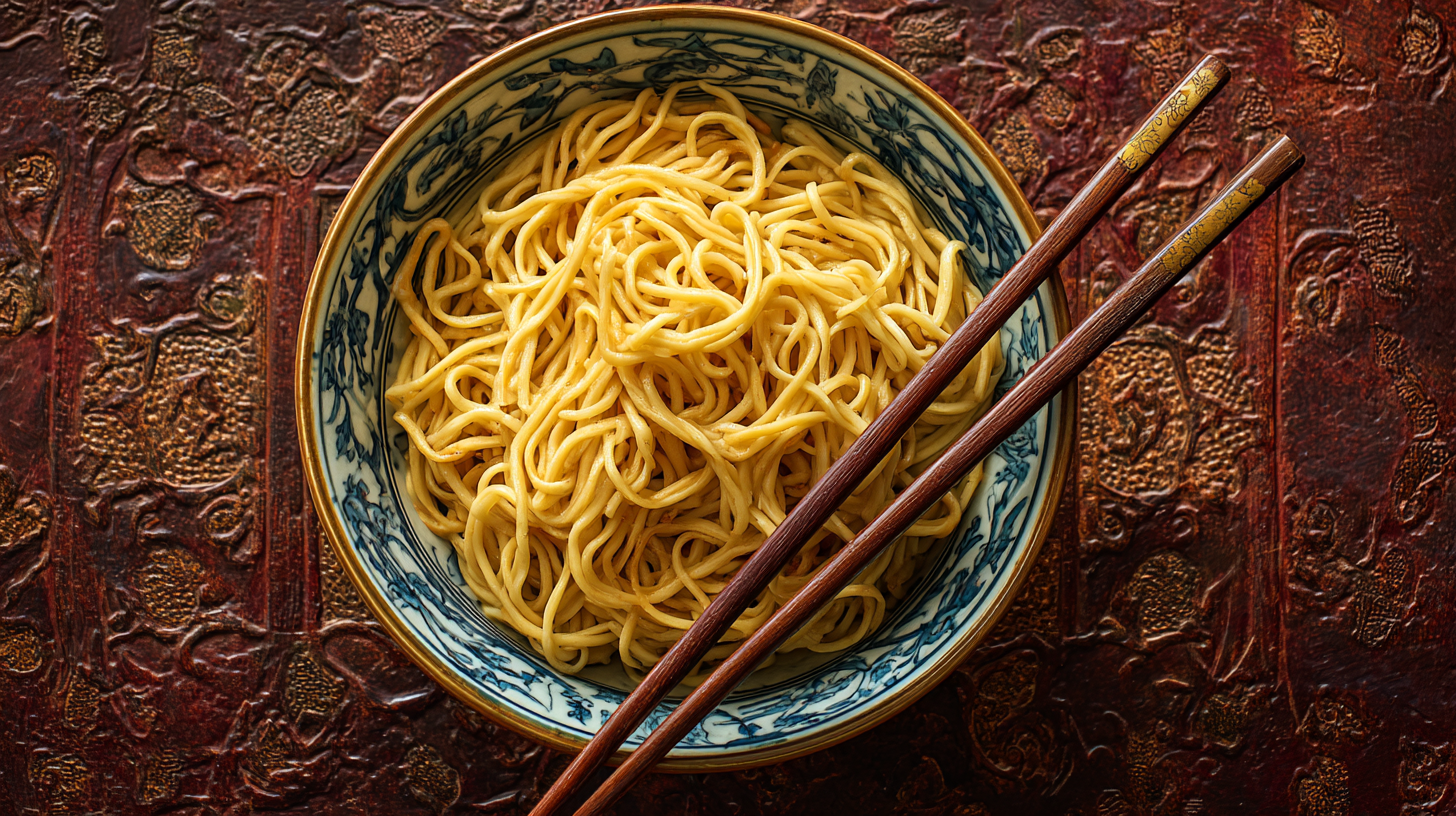
There’s something comforting about a bowl of Vietnamese egg noodles. With their silky texture and rich golden hue, these noodles are a staple in Vietnamese cuisine, often paired with flavorful broths, stir-fried with vibrant veggies, or served cold with tangy sauces. They’re versatile, quick to cook, and always satisfying.
Vietnamese Egg Noodles Recipe
Let’s dive into creating a delicious Vietnamese egg noodle dish that’s both flavorful and easy to prepare. Follow these steps to achieve perfectly cooked noodles paired with vibrant toppings and a rich sauce or broth.
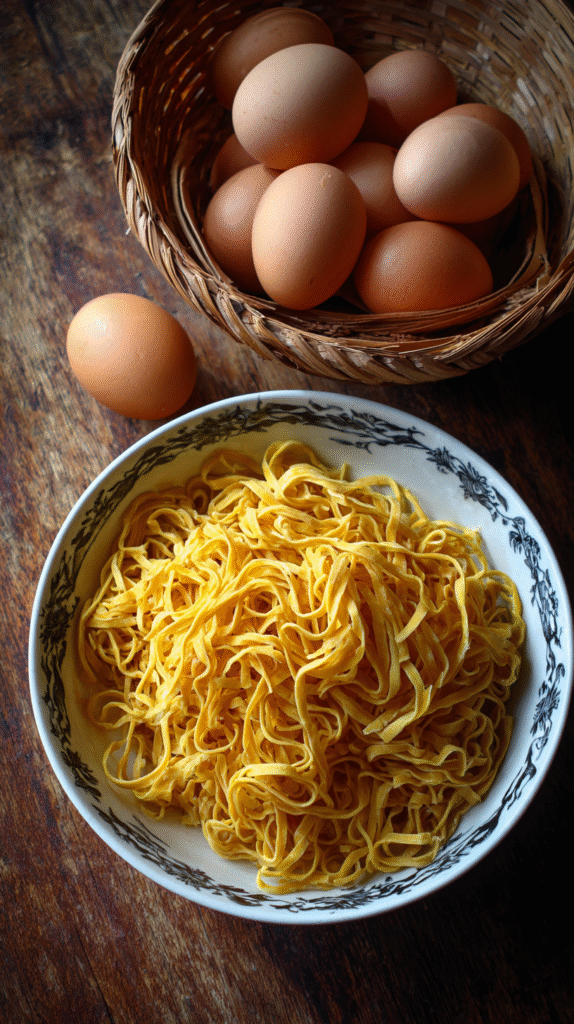
Ingredients
- 14 ounces (400 g) fresh Vietnamese egg noodles
- 2 tablespoons vegetable oil
- 3 garlic cloves, minced
- 1 medium onion, thinly sliced
- 1 cup thinly sliced carrots
- 1 cup shredded cabbage
- 1 cup cooked shrimp or sliced chicken (optional)
- 2 tablespoons soy sauce
- 1 tablespoon oyster sauce
- 1 teaspoon fish sauce
- 1/2 teaspoon sugar
- 1/4 teaspoon white pepper
- 2 green onions, sliced for garnish
- Chopped cilantro and lime wedges for serving
Instructions
- Prepare the noodles
Bring a large pot of water to a boil. Add the fresh egg noodles and cook for 1-2 minutes until softened but still firm. Drain immediately and rinse under cold water to halt cooking. Toss them with 1 tablespoon of vegetable oil to prevent sticking. Set aside.
- Cook the aromatics
Heat the remaining 1 tablespoon of vegetable oil in a large wok or skillet over medium heat. Add the minced garlic and sliced onion. Stir-fry for 1-2 minutes until fragrant and lightly golden.
- Add the vegetables and protein
Add the carrots and cabbage to the wok. Stir-fry for 3-4 minutes until the vegetables soften slightly but maintain a bit of crunch. If using shrimp or chicken, stir them in at this stage and cook until heated through.
- Mix the sauce
In a small bowl, whisk together the soy sauce, oyster sauce, fish sauce, sugar, and white pepper. Pour this mixture into the wok, stirring to coat the vegetables and protein evenly.
- Combine with noodles
Add the cooked noodles to the wok. Toss everything together gently, using tongs or chopsticks, ensuring the sauce coats the noodles entirely. Allow the noodles to heat through for about 2 minutes.
- Garnish and serve
Transfer the noodles to serving plates. Sprinkle with chopped green onions and cilantro. Serve with lime wedges on the side for a zesty finish. Enjoy immediately while the dish is warm and fresh.
Tips for Success
- For the best texture, avoid overcooking the noodles. They should remain firm and springy.
- Swap out vegetables based on seasonal availability or personal preference, such as bok choy or bell peppers.
- If you prefer a vegetarian option, skip the protein and add more vegetables or tofu.
This recipe highlights the versatility and vibrant flavors that make Vietnamese egg noodles a beloved staple in Vietnamese cuisine.
Ingredients
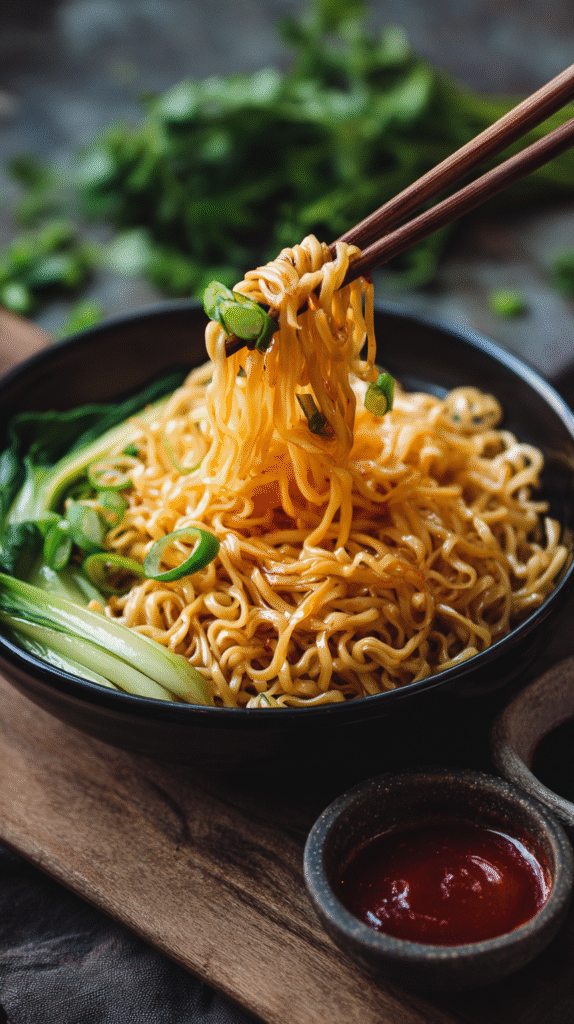
Here’s everything we need to make a flavorful Vietnamese egg noodle dish. Gather these ingredients to ensure the process flows smoothly.
For The Noodles
- 200 grams fresh egg noodles (or substitute with dried egg noodles, cooked per package instructions)
- Water for boiling
- 1 teaspoon salt (for boiling water)
For The Sauce
- 3 tablespoons soy sauce
- 1 tablespoon oyster sauce
- 1 teaspoon sesame oil
- 2 teaspoons sugar
- 1 teaspoon chili flakes (adjust to taste)
- 2 tablespoons water
For The Toppings
- 1 cup cooked shrimp or thinly sliced chicken (optional, for added protein)
- 1 cup mixed vegetables (such as bok choy, carrots, and bean sprouts)
- 2 green onions (sliced for garnish)
- 1 teaspoon toasted sesame seeds
- 1 wedge of lime (for serving)
Equipment Needed
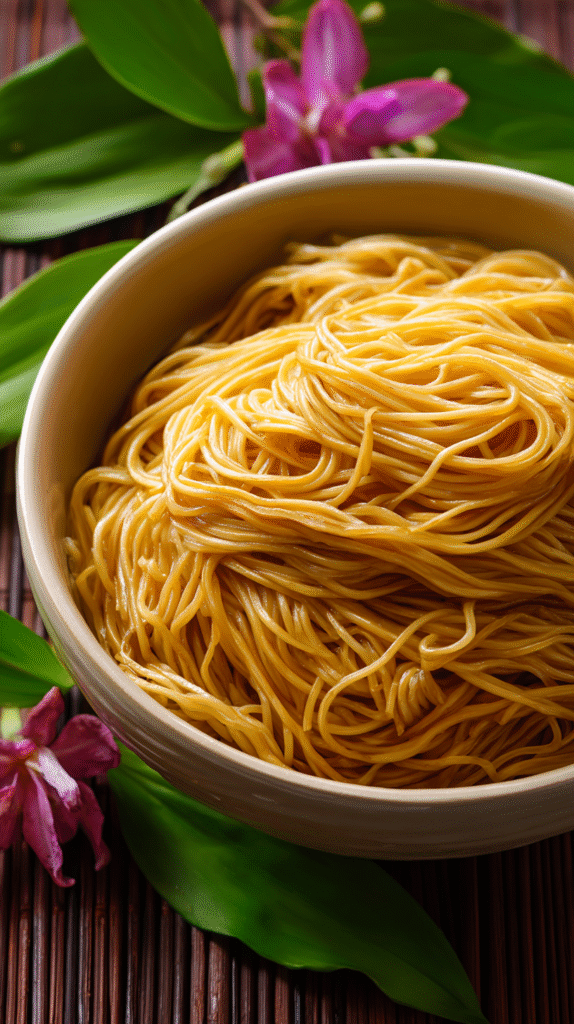
To prepare Vietnamese egg noodles effectively, having the right tools helps streamline the process and achieve the best results. Below is a list of recommended equipment, categorized for making the noodles from scratch and preparing the overall dish.
For Making Egg Noodles from Scratch
- Large mixing bowl: This is essential for combining flour, eggs, and other noodle-making ingredients until a cohesive dough forms.
- Fork or spatula: Use this to mix the ingredients thoroughly before kneading.
- Kitchen scale or measuring cups: Accurate measurements ensure the right dough consistency. Kitchen scales can provide precise results.
- Pasta machine or rolling pin: A pasta machine works wonders for rolling out the dough into uniformly thin sheets, but a rolling pin can also be used with patience and effort.
- Knife or pasta cutter: A pasta cutter simplifies slicing the rolled dough into even strands, but a sharp knife serves as an effective substitute.
- Drying rack: If you plan to store your noodles for later use, drying them on a rack provides proper airflow and prevents clumping.
For Preparing the Dish
- Large pot: Whether boiling fresh egg noodles or cooking dried ones, a large pot ensures even cooking and ample space for stirring.
- Colander: Once the noodles are done, a colander makes draining them quick and easy.
By using this equipment, we can recreate the luscious texture and vibrant flavor that make Vietnamese egg noodles a culinary favorite.
Directions
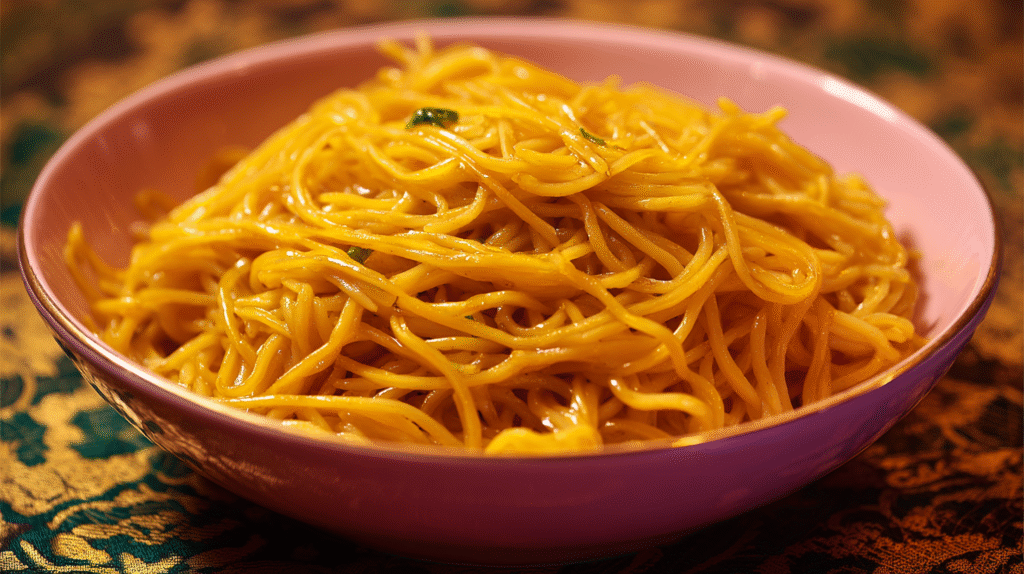
Let’s dive into making a delicious Vietnamese egg noodle dish. Follow these step-by-step instructions to create a meal bursting with vibrant flavors and textures.
Prep The Ingredients
- Measure 200 grams of fresh egg noodles (or dried as a substitute).
- Rinse and chop your mixed vegetables—commonly used are carrots, bok choy, and bean sprouts.
- Prepare your protein of choice: slice cooked shrimp, grilled chicken, or char siu pork into bite-sized pieces.
- Thinly slice 2 stalks of green onions and set aside for garnishing.
- Gather and measure toppings: toasted sesame seeds and 1 lime, cut into wedges.
Make The Sauce
- In a small bowl, combine:
- 2 tablespoons soy sauce
- 1 tablespoon oyster sauce
- 1 teaspoon sesame oil
- 1 teaspoon sugar
- 1/2 teaspoon chili flakes (adjust to your heat tolerance)
- Whisk until the sugar dissolves, and the mixture is smooth. Set the sauce aside.
Cook The Noodles
- Boil a large pot of water and add a pinch of salt.
- If using fresh egg noodles, cook for 2-3 minutes. For dried noodles, follow the package instructions.
- Drain the noodles in a colander and rinse under cold water to stop cooking. Toss with 1 teaspoon sesame oil to prevent sticking.
Assemble The Dish
- Heat a large skillet or wok over medium heat. Add a splash of oil.
- Stir-fry the chopped vegetables for 2-3 minutes until slightly tender but still crisp.
- Add the cooked protein to the skillet and stir for 1-2 minutes to warm through.
- Toss the cooked noodles into the skillet, then pour the sauce evenly over the top. Mix thoroughly to coat all ingredients.
- Plate the noodle dish and garnish with sliced green onions, toasted sesame seeds, and a lime wedge on the side. Enjoy!
Tips For Success
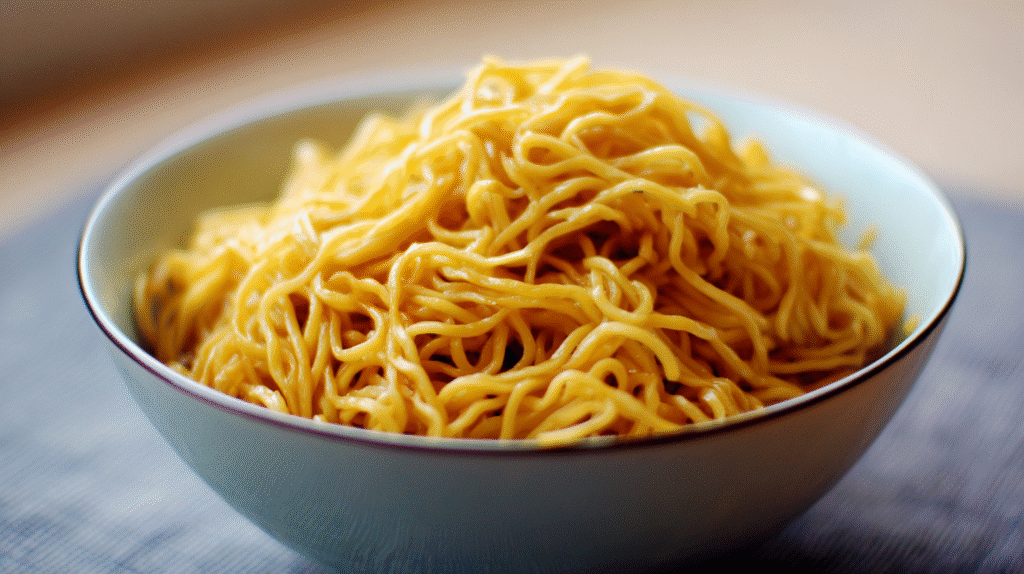
To perfect our Vietnamese egg noodles recipe and ensure every bite delivers its authentic, satisfying flavor, follow these expert tips:
- Choose Fresh Noodles When Possible
Fresh egg noodles provide the best texture—silky, soft, and chewy. If substituting with dried noodles, boil them just until tender and rinse with cold water immediately to stop cooking and remove starch.
- Prep Ingredients Ahead of Time
Vietnamese cooking is fast-paced. Slice vegetables, measure sauces, and prepare protein before starting. This will help maintain the flow and avoid overcooking.
- Use High Heat for Stir-Frying
When stir-frying, use high heat to cook ingredients quickly and lock in their flavor. Ensure your pan or wok is preheated to avoid sticking and to achieve that slight caramelization on vegetables and protein.
- Balance the Sauce Flavors
Our sauce mix of soy sauce, oyster sauce, sesame oil, sugar, and chili flakes defines the dish. Adjust the saltiness, sweetness, and spiciness to suit your taste. Start small and build flavors gradually.
- Don’t Overcook the Noodles
Egg noodles cook quickly. Overcooking results in a mushy texture, so stay attentive during boiling. A quick rinse under cold water after cooking firms them up and readies them for stir-frying or immediate serving.
- Garnish Generously
Finish the dish with fresh toppings like green onions, toasted sesame seeds, and lime wedges. These not only enhance the flavor but also add vibrant color and freshness.
- Experiment With Add-Ins
Incorporate your favorite vegetables or protein. Try julienned carrots, bell peppers, or tofu for a vegetarian twist. Adding cooked shrimp or chicken also complements the noodles beautifully.
- Invest in Quality Equipment
A good non-stick skillet or wok, sharp knife, and drying rack (if making noodles from scratch) will simplify preparation and ensure professional results.
Variations And Substitutions

Vietnamese egg noodles are incredibly versatile, offering countless opportunities to adapt recipes to fit our taste preferences, dietary needs, or ingredient availability. Let’s dive into some popular variations and explore creative substitutions to make these dishes your own.
Dry Egg Noodles with Char Siu Pork
For a delicious dry noodle option, we can keep things simple yet flavorful by tossing egg noodles with a sauce mixture of soy sauce, oyster sauce, and sesame oil. We then top it with slices of tender char siu pork and add a sprinkle of cilantro or green onions for freshness. If char siu pork isn’t available, we can substitute with grilled chicken, roasted duck, or stir-fried tofu for a vegetarian option. Gluten-free noodles can also replace traditional egg noodles, providing an alternative for dietary restrictions.
Stir-fried Egg Noodles with Beef
Stir-fried egg noodles with beef are a hearty choice. In this variation, noodles are stir-fried with thinly sliced beef, vegetables like bean sprouts, bok choy, onions, and carrots, and seasoned with soy sauce and oyster sauce. For a substitute, we can use shrimp, chicken, or even tempeh for a plant-based version. If we’re feeling creative, swapping out traditional vegetables with bell peppers, snap peas, or broccoli can add unique textures and flavors.
Egg Noodles with Wonton
When it’s time for a brothy dish, egg noodles with wontons are a classic pick. Here, savory wontons filled with seasoned ground meat and vegetables are served in a rich broth made from pork bones and vegetables, paired with thin egg noodles. To adapt, vegetarian wontons made with tofu and mushrooms can provide a satisfying alternative alongside a vegetable-based broth. For a quicker solution, we can substitute store-bought dumplings for homemade wontons without sacrificing too much flavor.
Creative Substitutions
Egg noodles themselves can be swapped with whole-wheat noodles, rice noodles, or even spiralized vegetables like zucchini for a low-carb alternative. When preparing noodle sauces, experimenting with tamari instead of soy sauce or coconut aminos for a soy-free option can diversify our flavor profile. Additionally, if sesame oil is unavailable, a light drizzle of olive oil with a pinch of toasted sesame seeds can serve as an effective replacement.
By tailoring these dishes to our preferences, we can uncover endless ways to enjoy Vietnamese egg noodles while accommodating personal tastes and dietary needs. The flexibility these noodles offer ensures there’s always room for creativity in the kitchen.
Storing And Reheating
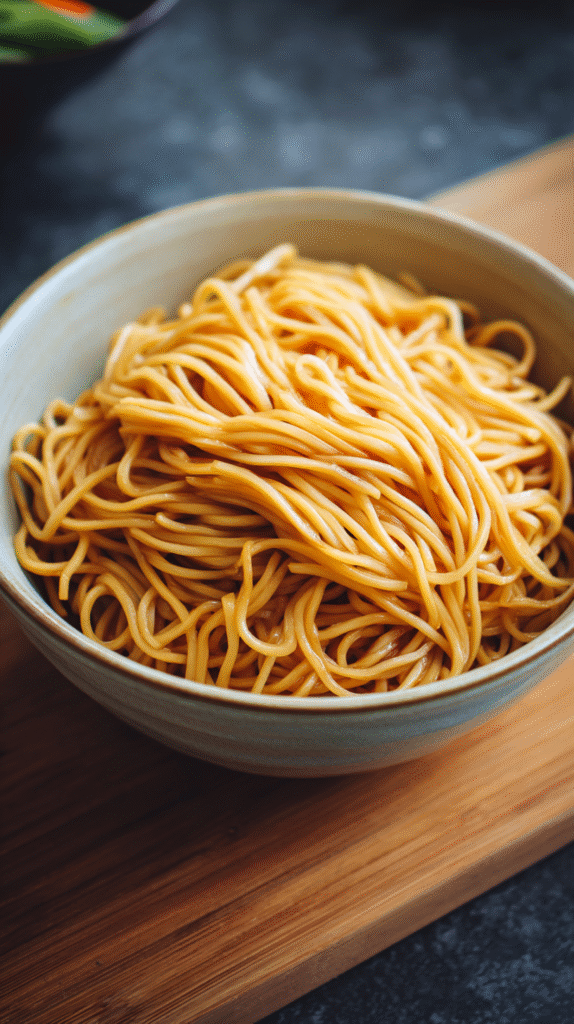
When it comes to preserving the delicate texture and fresh taste of Vietnamese egg noodles, proper storage and reheating are key. Whether you’ve made your noodles from scratch or used store-bought ones, here’s how we recommend storing and reheating them to enjoy their best quality.
Storing Egg Noodles
Freezing
For long-term storage, freezing is the most reliable method. We start by tossing the freshly cut noodles in flour to keep them from sticking together. Spread the floured noodles out in a single layer on a clean baking sheet or cutting board. Allow them to air dry at room temperature for about an hour.
Once semi-dry, transfer the noodles into an airtight freezer bag or container. Press out as much air as possible before sealing to minimize the risk of clumping. Frozen noodles can be stored for up to three months without losing their flavor or texture.
Refrigerating
If you plan to use your egg noodles soon, refrigerating is a convenient option. It’s best to store uncut dough and roll it out fresh before cooking. When refrigerated, the dough should ideally be used within 24 hours to maintain its smooth, pliable consistency.
For pre-cut fresh noodles, keep them in a sealed container lightly dusted with flour. Make sure the container is airtight to prevent them from drying out.
Reheating Egg Noodles
Reheating cooked noodles while retaining their springy texture requires a careful approach. Start by adding a splash of water or broth to the noodles when reheating. This helps maintain moisture and prevents them from becoming mushy.
- Microwave Method: Place the noodles in a microwave-safe dish, cover it with a damp paper towel, and heat in short, 30-second intervals until warmed through, stirring gently in between to ensure even heating.
- Stovetop Method: For a more even reheat, toss the noodles in a hot skillet or wok with a bit of oil or sauce. Stir-fry on medium heat until they are thoroughly warmed.
Avoid reheating multiple times as this can make the texture rubbery and the flavors less vibrant.
Conclusion
Vietnamese egg noodles truly bring a world of flavor and creativity to our kitchens. Whether we’re savoring them in a comforting soup, tossing them in a quick stir-fry, or experimenting with our own unique twists, they never fail to impress. Their adaptability makes them a joy to cook with and a delight to eat.
Let’s embrace the endless possibilities these noodles offer and have fun exploring new recipes and variations. With a little preparation and the right ingredients, we can create meals that are not only delicious but also beautifully reflect the vibrant spirit of Vietnamese cuisine.
Frequently Asked Questions
1. What are Vietnamese egg noodles made of?
Vietnamese egg noodles are typically made from wheat flour, eggs, and water. These ingredients give the noodles their signature silky texture and rich golden color.
2. What dishes can I make with Vietnamese egg noodles?
Vietnamese egg noodles can be enjoyed in soups, stir-fries, or cold dishes. For example, they pair wonderfully with broths, vegetables, and proteins like shrimp or chicken, and can also be served with tangy sauces.
3. Can I substitute fresh egg noodles with dried ones?
Yes, dried egg noodles can be used if fresh ones are unavailable. However, fresh noodles offer a better texture and flavor.
4. How do I store Vietnamese egg noodles for freshness?
For long-term storage, freeze freshly cut noodles in an airtight container for up to three months. For short-term use, refrigerate them in an airtight container.
5. What equipment do I need to prepare Vietnamese egg noodles?
Essential equipment includes a large pot, colander, skillet, and basic tools like a spatula or knife. If making noodles from scratch, you’ll need a mixing bowl, kitchen scale, rolling pin or pasta machine, and drying rack.
6. How do I reheat Vietnamese egg noodles without overcooking them?
Reheat noodles by adding moisture using water or broth. Use a microwave or stir-fry them on high heat to maintain their texture. Avoid reheating multiple times to preserve quality.
7. What’s the best way to cook Vietnamese egg noodles?
Boil the noodles in salted water for a few minutes, stir-fry them quickly with high heat, or serve them cold depending on your recipe.
8. Are Vietnamese egg noodles suitable for vegetarian dishes?
Yes, Vietnamese egg noodles can be used in vegetarian dishes. Swap meat for tofu or additional vegetables and customize the sauce to suit your preference.
9. Can I adjust the flavors in the sauce for egg noodles?
Absolutely! Balance flavors by adjusting ingredients like soy sauce, oyster sauce, sugar, chili flakes, or lime juice according to your taste.
10. What are some popular variations of Vietnamese egg noodle dishes?
Popular variations include stir-fried egg noodles with beef, dry egg noodles with char siu pork, and egg noodles with wontons. These dishes can be tailored for different dietary needs.
11. How do I prevent my noodles from clumping during cooking?
To prevent clumping, stir the noodles immediately after adding them to boiling water and rinse them with cold water after draining.
12. Why is using fresh noodles recommended?
Fresh noodles offer a softer, more authentic texture and absorb sauces better compared to dried noodles.
13. Can I freeze homemade egg noodles?
Yes, coat homemade noodles in flour, portion them into airtight containers, and freeze for up to three months to preserve their freshness.
14. What are some tips for perfect Vietnamese egg noodle dishes?
Use fresh ingredients, prep everything ahead of time, cook with high heat, balance the sauce flavors, and garnish generously for added flavor.
